Great Dane
The Great Dane is a German breed of domestic dog known for its large size.[3]
| Great Dane | |||||||||||||||||||||
|---|---|---|---|---|---|---|---|---|---|---|---|---|---|---|---|---|---|---|---|---|---|
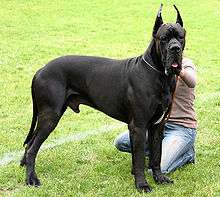 | |||||||||||||||||||||
| Other names |
| ||||||||||||||||||||
| Common nicknames | Apollo of Dogs, Gentle Giant[1] | ||||||||||||||||||||
| Origin | Germany | ||||||||||||||||||||
| |||||||||||||||||||||
| |||||||||||||||||||||
| Dog (domestic dog) | |||||||||||||||||||||
The record holder for the tallest dog ever is a Great Dane called Zeus (died September 2014; aged 5), who measured 111.8 cm (44.0 in) from paw to shoulder.[4][5] The tallest living dog is another Dane named Freddy, measuring 103.5 cm (40.7 in).[6]
History
In Austria and Germany the Molossian hound, the Suliot dog and other imports from Greece were used in the 18th century to increase the stature of the boarhounds.[7][8][9][10][11][12]
Hunting dog
In the middle of the 16th century, the nobility in many countries of Europe imported strong, long-legged dogs from England, which were descended from crossbreeds between English Mastiffs and Irish Wolfhounds. They were dog hybrids in different sizes and phenotypes with no formal breed.[13] These dogs were called Englische Docke or Englische Tocke – later written and spelled: Dogge – or Englischer Hund in Germany. The name simply meant "English dog". Since then, the English word "dog" has come to be associated with a molossoid dog in Germany[14] and France.[15] These dogs were bred in the courts of German nobility, independent of the English methods, since the start of the 17th century.[16][17]
The dogs were used for hunting bear, boar, and deer at princely courts, with the favorites staying at night in the bedchambers of their lords. These Kammerhunde (chamber dogs) were outfitted with ornate collars, and helped protect the sleeping princes from assassins.[18][19]
While hunting boar or bears, the Englische Dogge was a catch dog used after the other hunting dogs to seize the bear or boar and hold it in place until the huntsman was able to kill it. When the hunting customs changed, particularly because of the use of firearms, many of the involved dog types disappeared. The Englische Dogge became rare, and was kept only as a dog of hobby or luxury.
Name change
In 1878, a committee was formed in Berlin which changed the name of the "Englische Dogge" (English mastiff derivatives) to "Deutsche Dogge" (German mastiff), this being the Great Dane. This laid the foundations from which the breed was developed.[20] During the 19th century, the dog was known as a "German boarhound" in English-speaking countries.[21] Some German breeders tried to introduce the names "German Dogge" and "German Mastiff" on the English market, because they believed the breed should be marketed as a dog of luxury and not as a working dog.[16] However, due to the increasing tensions between Germany and other countries, the dog later became referred to as a "Great Dane", after the grand danois[22] in Buffon's Histoire naturelle, générale et particulière in 1755.
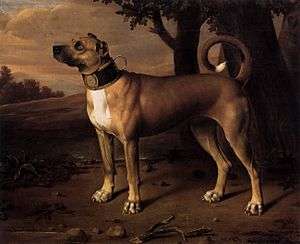 A "chamber dog" with a gilded collar, Brandenburg (Germany), 1705
A "chamber dog" with a gilded collar, Brandenburg (Germany), 1705 Great Dane from 1879.
Great Dane from 1879.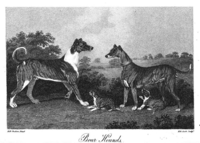 "Boar hounds" imported into Great Britain from the German Electorate of Hesse, 1807
"Boar hounds" imported into Great Britain from the German Electorate of Hesse, 1807
Description
The Great Dane is a large German domestic dog known for its giant size.[3][23]
As described by the American Kennel Club:
The Great Dane combines, in its regal appearance, strength, and elegance with great size and a powerful, well-formed, smoothly muscled body. It is one of the giant working breeds, but is unique in that its general conformation must be so well balanced that it never appears clumsy, and shall move with a long reach and powerful drive.[3] The Great Dane is a short-haired breed with a strong, galloping figure.[24]
In the ratio between length and height, the Great Dane should be square. The male dog should not be less than 30 in (76 cm) at the shoulders, a female 28 in (71 cm). Danes under minimum height are disqualified.[3] From year to year, the tallest living dog is typically a Great Dane. Previous record holders include Gibson, Titan, and George; however, the current record holder is a black Great Dane named Zeus that stood 111.8 cm (44.0 in) at the shoulder before his death in September 2014.[5] He was also the tallest dog on record (according to Guinness World Records),[5] beating the previous holder, the aforementioned George that stood 109.2 cm (43.0 in) at the shoulder.[25]
The minimum weight for a Great Dane over 18 months is 120 lb (54 kg) for males, 100 lb (45 kg) for females.[24][26] Unusually, the American Kennel Club dropped the minimum weight requirement from its standard.[27] The male should appear more massive throughout than the female, with a larger frame and heavier bone.[3]
Great Danes have naturally floppy, triangular ears. In the past, when Great Danes were commonly used to hunt boars, cropping of the ears was performed to make injuries to the dogs' ears less likely during hunts. Now that Danes are primarily companion animals, cropping is sometimes still done for traditional and cosmetic reasons. In the 1930s when Great Danes had their ears cropped, after the surgery, two devices called Easter bonnets were fitted to their ears to make them stand up.[28] Today, the practice is common in the United States, but much less common in Europe. In some European countries such as the United Kingdom, Ireland, Denmark, and Germany, and parts of Australia and New Zealand, the practice is banned or controlled to only be performed by veterinary surgeons.
Coat
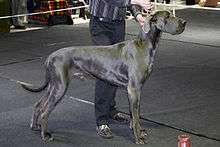

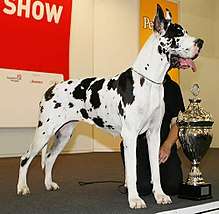
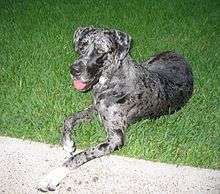
According to the breed-standard, varieties have five to six (depending on the standard) show-acceptable coat colors:[3][29]
- Fawn and brindle
- Fawn: The colour is yellow gold with a black mask. Black should appear on the eye rims and eyebrows, and may appear on the ears.
- Brindle: The colour is fawn and black in a chevron stripe pattern. Often, also, they are referred to as having a stripe pattern.
- Harlequin and black
- Black: The colour is a glossy black. White markings on the chest and toes are not desirable and considered faults.
- Harlequin: The base colour is pure white with black torn patches irregularly and well distributed over the entire body; a pure white neck is preferred. The black patches should never be large enough to give the appearance of a blanket, nor so small as to give a stippled or dappled effect. Eligible, but less desirable, are a few small grey patches (this grey is consistent with a merle marking) or a white base with single black hairs showing through, which tend to give a salt and pepper or dirty effect.
- Grey merle (Grautiger) dogs are acceptable in conformation shows under the FCI as the grey merle dogs can produce correctly marked black/white harlequin dogs, depending on the combinations. The aim for deleting the colour grey merle as a disqualifying fault is to provide a wider gene pool.[30] Their status is that they are "neither desirable nor to be disqualified".[31] Consequently, this colour must never obtain the highest grading at dog shows.[30]
- Mantle (in some countries referred to as Bostons due to the similar coloration and pattern as a Boston Terrier): The colour is black and white with a solid black blanket extending over the body; black skull with white muzzle; white blaze is optional; whole white collar preferred; a white chest; white on part or whole of forelegs and hind legs; white tipped black tail. A small white marking in the black blanket is acceptable, as is a break in the white collar.
- Blue: The colour is a pure steel blue. White markings at the chest and feet permitted. Never with fawn nuance or blackish blue colour.[32]
Other colours occur occasionally, but are not acceptable for conformation showing, and they are not pursued by breeders who intend to breed show dogs. These colours include white, fawnequin, brindlequin, merle, merlequin, blue merle, chocolate and fawn mantle. The white Great Dane coloring is typically associated with vision and hearing impairment.[33]
Temperament
The Great Dane's large and imposing appearance belies its friendly nature. They are known for seeking physical affection with their owners, and the breed is often referred to as a "gentle giant".[3][34]
Great Danes are generally well disposed toward other dogs, other noncanine pets, and familiar humans. They generally do not exhibit extreme aggressiveness or a high prey drive.[35] The Great Dane is a very gentle and loving animal and with the proper care and training is great around children, especially when being raised with them. However, if not properly socialized, a Great Dane may become fearful or aggressive towards new stimuli, such as strangers and new environments.[36]
Exercise
Like most dogs, Great Danes require daily walks to maintain their health. However, it is important not to over exercise this breed, particularly when young. Great Dane puppies grow very large, very fast, which puts them at risk of joint and bone problems. Because of a puppy's natural energy, Dane owners often take steps to minimize activity while the dog is still growing.[37][38]
Given their large size, Great Danes continue to grow (mostly gaining weight) longer than most dogs. Even at one year of age, a Great Dane continues to grow for several more months.[38]
Health
Great Danes, like most giant dogs, have a faster metabolism. This results in more energy and food consumption per pound of dog than in small breeds. They have some health problems that are common to large breeds, including bloat (gastric dilatation volvulus). To avoid bloat, a rest period of 40 minutes to one hour after meals is recommended before exercise.[39] Their average lifespan is 6 to 8 years; however, some Great Danes have been known to reach 10 years of age or more.[40][41] Like many larger breeds, Great Danes are at particular risk for hip dysplasia.
Dilated cardiomyopathy and many congenital heart diseases are also commonly found in the Great Dane, leading to its nickname: the heartbreak breed, in conjunction with its shorter lifespan. Great Danes also may carry the merle gene, which is part of the genetic makeup that creates the harlequin coloring.[42] The merle gene is an incomplete dominant, meaning only one copy of the gene is needed to show the merle coloring; two merle genes produce excessive white markings and many health issues such as deafness, blindness, or other debilitating ocular issues. Great Danes can also develop wobbler disease, a condition affecting the vertebral column. Since these dogs do grow at a rapid rate, the bones in their vertebae can push up against the spinal cord and cause weakness in the legs. This can be treated with surgery or may heal itself over time.[43]
Cultural significance
Animation
- Animation designer Iwao Takamoto based the Hanna-Barbera character Scooby-Doo on a Great Dane. He derived his design from sketches given to him by a Hanna-Barbera employee who bred Danes, and then endeavoured to make Scooby the opposite of a perfect pedigree, with a longer tail, bowed legs, small chin and a sloping back.[44][45]
- Astro from The Jetsons and Space Stars
- Dynomutt, Dog Wonder, a robotic Great Dane
- Elmer, a Great Dane in Oswald the Lucky Rabbit by Walter Lantz
- Danny, Jonathan Joestar's pet Great Dane in JoJo's Bizarre Adventure: Phantom Blood. He is killed by his stepbrother, Dio Brando, which establishes their generational rivalry that lasts throughout a majority of the story.
- DC Comics' Ace the Bat-Hound is commonly portrayed as a Great Dane.
Books
- In the Harry Potter novels, Hagrid's pet Fang is said to be a boarhound. The films used a Neapolitan Mastiff.
Comic strips
- Brad Anderson's titular comic strip character Marmaduke is a Great Dane.
Crime
- On 24 October 1975, Rinka, a Great Dane belonging to Norman Scott, was shot in a bungled attempt to murder Scott himself, in what became known as the Thorpe affair. In 1996, Scott Freeman and Barrie Penrose published Rinkagate: Rise and Fall of Jeremy Thorpe.[46]
Mascots
- The Great Dane was named the state dog of Pennsylvania in 1965,[47] and the University of Iowa had Great Danes, Rex I and Rex II, as mascots before the Hawkeye was chosen.[48]
- "Great Danes" is the nickname of the University at Albany. Their mascot is the Great Dane.[49]
- McGruff the Crime Dog, mascot of the US National Crime Prevention Council
Military
- Just Nuisance was the only dog to be officially enlisted in the Royal Navy. Done mainly as a morale booster for World War II enlisted troops, Nuisance proved to be a lasting legacy of the small Cape Town suburb of Simon's Town.
Film
- In each film version of Sir Arthur Conan Doyle's The Hound of the Baskervilles, a Great Dane was cast as the cursed hellhound that kills the Baskerville family.
- Chestnut: Hero of Central Park revolves around the inventive ways that the Great Dane is kept hidden from his new owners.
- Oliver & Company features Einstein, a Great Dane, and a member of Fagin's dog gang. He is friendly but dull-witted, protective of his friends, and provides the muscle for the gang.
- The Patriot, 2000 film starring Mel Gibson, features two Great Danes, named Mars and Jupiter.
Philosophy
- An unnamed Great Dane knocks Jean-Jacques Rousseau to the ground in Reveries of a Solitary Walker; he describes the singular feeling of peace and suspended identity that the shock of the collision brings about in him.[50]
See also
- Brindlequin
- Reichshund, term used in Germany for Bismarck's Great Danes and for a while the entire breed
References
- "Great Dane Dog Breed Information, Pictures, Characteristics & Facts - Dogtime". dogtime.com. Archived from the original on 14 February 2018. Retrieved 7 May 2018.
- https://www.akc.org/expert-advice/health/great-dane-life-span/
- "Great Dane Breed Standard". American Kennel Club. 1999. Archived from the original on 3 May 2005.
- "Tallest dog ever". Archived from the original on 3 March 2016.
- "Zeus, the world's tallest dog passes away at the age of 5". Guinness World Records. Archived from the original on 12 March 2016.
- "Tallest dog living (male)". Guinness World Records. Retrieved 30 March 2019.
- Jardine, William (1 January 1840). The Naturalist's Library. Lizards – via Google Books.
- Hancock, David. "Putting Dogs Before Breeds". Charwynne Dog Features. David Hancock. Archived from the original on 31 March 2017. Retrieved 28 October 2017.
- Hancock, David. "Hunting Down the Mastiffs of England". Charwynne Dog Features. David Hancock. Archived from the original on 19 November 2015. Retrieved 28 October 2017.
- Hancock, David. "Great Danes — Giant Hounds...Or What?". Charwynne Dog Features. David Hancock. Archived from the original on 24 July 2017. Retrieved 28 October 2017.
- Carleton, John William. The Sporting review, ed. by 'Craven'. p. 203.
suliot dog.
- Morris, Desmond. Dogs – The Ultimate Dictionary of Over 1,000 Dog Breeds. Ebury Press, 2001. ISBN 0-09-187091-7. Page 618.
- Ludwig Beckmann (1895). Geschichte und Beschreibung der Rassen des Hundes, Volume 1, p. 6 (in German)
- The German standard term for "dog" is Hund; the term Dogge is only in use for dogs of the mastiff type.
- The French standard term for "dog" is chien; the term dogue is only used for dogs of the mastiff type.
- Ludwig Beckmann. Geschichte und Beschreibung der Rassen des Hundes, Volume 1, 1895, p. 7 (German)
- Johann Täntzer. "Von den Englischen Hunden" ["On the English dogs"]. In Jagdbuch oder der Dianen hohe und niedrige Jagdgeheimnisse [Hunting-book, or Diana's high and low hunting secrets], Copenhagen, 1682 (in German): "Jetziger Zeit werden solche Hunde jung an Herrenhöfen erzogen, und gar nicht aus England geholet." English translation: "Today such dogs are bred at noblemen's courts, and not at all obtained from England." Cited in Ludwig Beckmann (1895). Geschichte und Beschreibung der Rassen des Hundes [History and description of the breeds of dogs], Vol. 1, p. 7
- Johann Täntzer (1682). "Von den Englischen Hunden" ["On the English dogs"]. In Jagdbuch oder der Dianen hohe und niedrige Jagdgeheimnisse [Hunting-book, or, Diana's high and low hunting secrets], Copenhagen. Cited in Ludwig Beckmann (1895). Geschichte und Beschreibung der Rassen des Hundes [History and description of the breeds of dogs], Volume 1, 1895, p. 9
- Johann Friedrich von Flemming (1719). "Von denen Englischen Docken" ["On the English mastiffs"]. Der vollkommene teutsche Jäger [The complete German hunter]. Leipzig. Volume 1, p. 169. Archived 6 October 2014 at the Wayback Machine. "... such a chamber-hound is mostly put about with a strong leather collar covered with green velvet, on which there are silver letters or the master's name or arms. ... Such body-dogs are also assigned beautiful collars of red or green plush with brass letters."
- FCI Breed Standard Great Dane 2012
- S. William Haas (2003). Great Dane: A Comprehensive Guide to Owning and Caring for Your Dog (Series: Comprehensive Owner's Guide), Kennel Club Books, 2003, p. 13
- Depiction of Buffon's grand danois (Bibliothèque nationale de France) Archived 22 February 2015 at the Wayback Machine
- Becker, The Great Dane – Embodying a Full Exposition of the History, Breeding Principles, Education, and Present State of the Breed (a Vintage Dog Books Breed Classic): Embodying a Full Exposition the History, Breeding Principles, Education, and Present State of the Breed, Published by READ BOOKS, 2005, ISBN 1-905124-43-0.
- "The Home for Dog Owners and Those Working with Dogs: The Kennel Club". thekennelclub.org.uk. Archived from the original on 15 May 2007.
- "Giant George, Guinness World Record, Tallest Dog – giantgeorge". Archived from the original on 12 March 2016.
- "Dogs New Zealand -". www.nzkc.org.nz. Retrieved 7 May 2018.
- Cunliffe, Juliette (2005). The Complete Encyclopedia of Dog Breeds. UK: Parragon Publishing. ISBN 1-4054-4389-8.
- "Easter Bonnets for Dogs Make Ears Stand Erect" Popular Mechanics, December 1934
- FCI Breed Standard N° 235 Great Dane (Deutsche Dogge) Archived 6 October 2014 at the Wayback Machine (PDF)
- Circular 67/2013 of the FCI, 23/12/2013 Archived 7 January 2014 at the Wayback Machine (PDF)
- "F.C.I. Standard N° 235, P. 7" (PDF). fci.be. Archived (PDF) from the original on 25 October 2017. Retrieved 7 May 2018.
- Tapio, Marjo (25 February 2019). "Great Dane Standard FCI" (PDF). www.fci.be. Retrieved 25 February 2019.
- "Great Dane Colors, Coat Patterns & Markings". All About Great Danes. jZ Canine Publishing. n.d. Archived from the original on 29 November 2016. Retrieved 4 December 2016.
There are some health concerns with certain Danes due to recessive genes and some coat colors are a result of these genes. For instance, genetically white Great Danes are typically vision and hearing impaired.
- "Great Dane". Animal Planet. Archived from the original on 19 June 2012.
- Great Dane: A Comprehensive Guide to Owning and Caring for Your Dog, Kennel Club Book, 2003, ISBN 1-59378-273-X
- Biniok, Janice (10 August 2010). Great Dane : a practical guide for the Great Dane. Neptune City, NJ: T.F.H. Publications. ISBN 978-0-7938-4178-3.
- "Great Dane Adoption Society – UK rescue and rehoming". danes.org.uk. Archived from the original on 14 September 2009.
- "All about Great Danes.com". All about Great Danes.com Exercise Advice. 2012. Archived from the original on 9 April 2012. Retrieved 5 April 2012.
- "Great Dane - Dogs 101 - Animal Planet". www.animalplanet.com. Archived from the original on 15 March 2018. Retrieved 7 May 2018.
- "Summary results of the Purebred Dog Health Survey for Great Danes" (PDF). Kennel Club/British Small Animal Veterinary Association Scientific Committee. 2004. Archived from the original (PDF) on 16 August 2010. Retrieved 29 March 2010.
- "National Health Survey" (PDF). Great Dane Club of America. 2004. Archived from the original (PDF) on 10 May 2012. Retrieved 29 March 2010.
- "The Merle Gene and Multiple Ocular Abnormalities". Eye Care for Animals. Archived from the original on 12 December 2013.
- "World Small Animal Veterinary Association World Congress Proceedings, 2004". 30 March 2015. Cite journal requires
|journal=(help) - "Iwao Takamoto, 81, the Animation Artist Who Created Scooby-Doo, Dies" Archived 20 December 2016 at the Wayback Machine, by Susan Stewart, 10 January 2007, The New York Times
- "Iwao Takamoto, cartoonist who created Scooby-Doo, dies at 81" Archived 28 January 2007 at the Wayback Machine, The Associated Press, 9 January 2007, Canadian Broadcasting Corporation
- Ingham, Robert (1999). "The Jeremy Thorpe Story" (PDF). Journal of Liberal Democrat History. 23 (Summer): 22–23. Retrieved 1 June 2018.
- State Symbols USA Archived 9 April 2008 at the Wayback Machine, www.statesymbolsusa.org
- "Pop quiz: How well do you know the UI campus? - fyi — University Relations Publication — The University of Iowa". uiowa.edu. Archived from the original on 30 June 2013. Retrieved 3 May 2014.
- "Symbols of UAlbany". www.albany.edu. Archived from the original on 18 September 2015. Retrieved 2 December 2015.
- Rousseau, Jean-Jacques. Reveries of a Solitary Walker. Trans. Charles E. Butterworth. Indianapolis: Hackett Publishing (1992), pp. 15–18.
External links
| Wikimedia Commons has media related to Great Dane. |
- Giant George is the World's Biggest Dog
- The Great Dane Dog historical marker in Savannah, Georgia